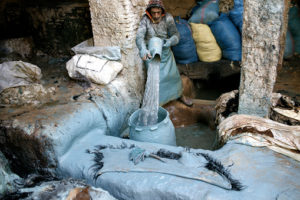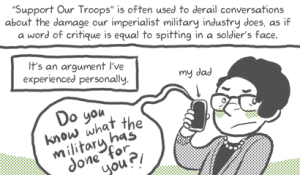(This article has been translated in Portuguese here.)
“The clothing industry is the second largest polluter in the world…second only to oil,” Eileen Fisher, founder of the eponymous line of clothes, told a NYC audience in 2015. “It’s a really nasty business…it’s a mess.”
When we get dressed every day, many of us choose what we wear according to what we want to express about ourselves.
Maybe you only wear the latest from your favorite designers because you love the status it gives you, or perhaps you rock used clothes that you’ve adorned yourself as a fuck you to society.
We each have our own aesthetic and our own reasons for wearing the outfits that we do.
Most of us know that thrill of finding the perfect outfit and the fun of shopping for new pieces to add to our already overflowing wardrobe.
When we shop, new clothes are folded and stacked precisely on bright shelves or hung in neat rows of complementary colors and contrasting fabrics. We buy “problem-solving” pieces: push-up bras, tummy-control panels, thigh-slimming leggings, and bulge-smoothing undergarments.
You could have four outfits per day and still find a need for more.
But where does it all come from? And at what cost? Why is the fashion industry called the second-dirtiest industry by an industry insider?
It turns out that fashion demands by the western world cause illness and injury to those who manufacture fabric. It has made once -thriving waterways uninhabitable by even the smallest organism.
Our desire for clothes on-demand has introduced toxic chemicals into the environment, polluted the air to the point that locals can’t go outside, and created so much waste.
On our side of things – when we shop – everything is so clean, and it’s difficult to imagine what it took to get that new dress, or that sweater, or that pile of trendy items you are eager to wear.
In this two-part series, we’ll look at some of the many negative impacts the fashion industry has on the environment so that you can understand where your clothes come from.
In the second half, we’ll offer suggestions on how to source your clothes in a way that bypasses the negative environmental impacts of the fashion industry (and, incidentally, is less expensive because that’s what happens when you check out of consumerism).
1. A Lot of Dangerous Chemicals Are Used in Cloth Production
So maybe you order a new shirt, one that has #ShePersisted written across the front.
It arrives, days later, and the cloth is fresh, and clean, and so soft. The last thing it brings to mind is how dirty its history is. But toxic chemicals have been used at nearly every production stage to make the cloth needed for your new shirt – even if the shirt is 100% cotton or flax-based.
Sure, cloth used to be made entirely from plants or animals, but with the rise of pesticides in the 1950s, most cloth production requires massive amounts of chemical processing.
In the case of fabrics like polyesters, not only are they synthetic petrochemicals, they also contribute 18% of the market share of plastics. Or, in other words, buying plastic-based clothes increases the demand for crude oil.
Pesticides
Your new #ShePersisted shirt is 100% cotton, dyed bright pink, and fits like a dream. It’s your new protest shirt, one that you’ll wear out running errands, too. But to get the shirt to you, the cotton had to be grown first. It’s a water-guzzling plant, but we’ll get to that in a minute.
While cotton covers just 2.4% of cultivated land on earth, it’s treated with 6% of pesticides used.
When plants are grown to create fibers for clothes, the plants are heavily sprayed with harsh pesticides – powerful poisons sprayed over large areas in order to kill anything that might eat the plants – which leech into our groundwater and flow into streams, rivers, and the ocean.
This means that localized pesticide use affects all waterways on their way to the ocean and the plants and animals in them.
And in certain places, like Central and West Africa where small farmers exclusively grow cotton, their reliance on pesticides can have catastrophic results on their health and economic stability.
Once these poisons are in the environment, people can absorb them into their bodies. Many chemical pesticides are known to cause cancer, reproductive harm, endocrine disruption, and developmental issues.
The World Health Organization estimates that 3 million people suffer from pesticide poisoning annually – some of these cases result in permanent disability or death.
Some pesticides, including the main one for cotton – Endosulfan – is a persistent organic pollutant, which means that it doesn’t break down or wash away. Instead, it stays and builds in concentration to the detriment of the people, animals, insects, and plants that live in the area.
Although Endosulfan has been banned in Europe, it’s still widely used in Ethiopia, where families who survive on growing cotton make barely one dollar per day, spend up to 60% of their proceeds on pesticides, and suffer from health issues caused by pesticide use.
Families risk their health to grow cotton that will be exported and made into jeans or T-shirts – the same jeans and T-shirts many of us may have forgotten we still own.
Leather
And cotton production has nothing on leather-tanning.
More than 30 different types of harsh chemicals are used in the process of tanning leather.
Most of those used in the tanneries are flushed down the drain and flow into many local rivers.
These chemicals give leather workers skin and respiratory diseases, and much of the local community suffers from chronic fevers, skin diseases, aches, dizziness, nausea, and diarrhea.
The local water sources in Hazaribagh, Bangladesh – one of the world’s centers for curing leather – are so polluted that nothing lives in them anymore.
Shirin Akhter, the founder of an NGO called Karmojibi Nari (Working Women), told Mother Jones that “We are a country of rivers, but we have no water to drink.”
Most of the leather cured in Hazaribagh goes toward meeting the endless demand for leather shoes, belts, purses, and jackets by the Western world.
This means the people who work – in poverty – to cure leather for export do so in an environment so toxic that the nearby rivers have an overpowering chemical odor, and they suffer chronic illnesses.
2. Synthetic Fibers Are Harsh on the Environment at All Stages
Nylon and polyester are plastics, which is why they don’t breathe and feel sticky. It also means they have toxic by-products, which are just dumped.
For example, when nylon is made, the process releases nitrous oxide. Nitrous oxide is a greenhouse gas that is 300 times more harmful to the environment than carbon dioxide.
Like cotton, polyester requires massive amounts of water, and nylon and polyester are made of petrochemicals. That is, they are products of the oil industry, so they also don’t biodegrade easily.
Like other plastics, they’ll be around for a long time.
3. Bamboo Requires a Ton of Harmful Chemicals to Make It into Silky-Smooth Fibers
In the past decade, bamboo was sourced to make fabrics with the claim that it was sustainable.
And it is completely sustainable – to grow. As a crop, compared to the water and pesticide requirements of cotton, bamboo is great.
It needs little water, grows rapidly (up to four feet a day), and most bamboo grown for products is grown without pesticides.
The problem comes in when it’s time to make it into cloth.
Bamboo is a strong, woody grass and to make it soft and supple – something that we would want to wear on our skin – requires a breakdown of its fibers. This is rarely done mechanically, as it much more labor-intensive and costly to break down fibers chemically. Carbon disulfide and sodium hydroxide, the main chemicals used to spin bamboo into cloth, have many negative effects on humans. Carbon disulfide, in particular, causes neural disorders among workers.
Because most of the chemicals can’t be re-used, they’re either dumped or evaporate into the environment, further endangering locals.
4. More Than Two Thousand Gallons of Water Go into Making Just One Pair of Jeans
The people of Flint, MI still can’t drink clean water straight out of their taps.
Their water is still polluted with lead, bacteria, and carcinogenic THMs. Flint is one more example of the global issue of access to clean drinking water.
At least one in ten people worldwide don’t have access to clean drinking water, and the way we bottle and serve water is another pollutant.
And even more, to produce a single pair of jeans requires an estimated 1,800 – 2,630 gallons of water. It takes 1,600 gallons of water to grow the amount of cotton necessary, including the dyeing and finishing processes.
5. Factories Pollute the Air
Unless your clothes come from a boutique with local manufacturing or are handmade, they most likely have been assembled in an overseas factory.
Workers live at these factories year-round. Factory workers earn from $.24 in Bangladesh to $1.26 in China per day just to make the trendy clothes you wear for a season or two.
I spoke with Paula Pfotenhauer, who has worked in all aspects of the fashion industry over her 40+ year career. For a time, she was in Quality Control and Inspections and traveled overseas. On one trip to China, she traveled around a factory center, Shenzhen, Guangdong.
The air pollution was terrible, she remembers. “It was so grey, even on a sunny day, I had to look straight up to see any sky because there was a thick grey smog. Even the buildings were covered with a grey soot. It was just – everything, everywhere was grey.”
“The manager couldn’t go outside because she couldn’t breathe. Most of the people who work there had to stay in a lot [because they had respiratory problems]. They just didn’t go outside.”
The factories that make our clothes affect our quality of life.
On a global scale, they’re contributing to climate change by infusing carbon dioxide into the air, and on a local scale, they pollute the air so badly that locals can no longer go outside.
6. Fashion Houses Order More Cloth Than They Will Use – and Then Dump It
Before your new outfit gets to the stores, the fashion house has gone through a series of steps to get it there.
First, the item must be designed. Then, samples are made. But the samples aren’t made with just the fabric that makes it to the store. Fashion houses design and order different types of fabric and patterns – and they order enough bolts of each one to make all the clothes they need.
The bolts come in and they make up samples. When they decide which ones they’ll send to stores, the stores order them, leaving a pile of bolts. These bolts get dumped or occasionally picked up and taken to fabric warehouses where the majority of them rot away.
It’s important to understand the shear size of the fashion industry. Ten thousand to thirty thousand T-shirts are churned daily out of one factory in one country.
If a fashion company orders fabric bolts for their new, on-trend samples, and don’t use them, hundreds of bolts of fabrics are just gone to waste.
7. The Amount of Waste
The average clothing factory employs 1,500-2,000 workers. They take in orders of approximately 30,000 items for one piece of clothing and have a short time to fill the order.
If mistakes happen – and they happen frequently – the fashion house will return the entire order and, the entire lot is dumped. It doesn’t matter how small or big the mistake is.
If, for example, a zipper doesn’t work or the batting bunches up after a single wash, the entire lot is dumped.
“You don’t realize the waste involved,” Pfotenhauer explains. “A lot of companies don’t want defective merchandise out so…they burn it.” Burning synthetic fabric contributes to air pollution, not to mention the waste of having made the cloth and other items like zippers, buttons, and drawstrings to not end up using it.
Pfotenhauer drove between factories in Guangdong and shared additional insights.
I traveled between two cities, about 80 km apart, and all I could see were factories as far as the eye could see. I was in shock because, in the factory, just one tiny factory among the sea of factories, they were making 20,000 striped polos a day. It was hard knowing that this was a tiny, tiny factory of maybe 6-800 sewers and this was a small piece of everything made. The vastness of it humbled me.
In each of those factories, every day of the week, people make tens of thousands of items, and from each of these factories, a constant stream of waste and air pollution is churned out alongside the items they make.
8. Fast, Cheap Fashion Means That Clothes Are Not Made to Last and Will Be Discarded Each Year
Pfotenhauer tells the story of when she was working in quality control and a merchandiser asked her, “In the US, do they just use dish towels once and then throw them away?”
She responded, “What? What do you mean?”
And she asked me again, “Do they just throw the dish towels away after using them?”
I said, “No! We wash them.” But she was asking because they made so many of them every day, and she couldn’t see how people could keep buying them.”
This is an example of how much is shipped to the US.
The fast fashion industry means that fashion is cheaper, but it’s poorly made and doesn’t fit well.
In the past, people bought clothes to wear for years – for the rest of their lives, even.
Now, the average US American woman wears each item just seven times, and the US throws away 12.8 million tons of clothes each year.
Consumerism and the fast turnover of fashion trends have people buying more clothes, annually, than ever before.
We think we’re just buying a new shirt or a cute pair of jeans, but we’re contributing to water and air pollution, water scarcity, and, worst, hazardous work and living conditions for the people who are working to make our clothes.
In Hazaribagh, the people who tan leather live in extremely polluted conditions and earn hardly enough to survive while in Ethiopia. One bad year can send farmers who grow cotton for our clothes into debt they can’t get out of.
They, too, live in land that is polluted with the very pesticides needed to grow cotton – pesticides that wouldn’t be there if it weren’t for the high demand of clothing.
They have high suicide rates because of debt and live, at best, hand-to-mouth.
All over the world, and particularly the Global South, people live and work for under one dollar a day. They work in polluted and unsafe conditions that affect their health and in situations that they can’t easily walk away from because it’s not easy to find a better job.
Are your new, trendy clothes worth this human cost?
A healthy, vibrant Earth is the best thing we can give ourselves. When the environment is polluted, it leads to chronic illness and unhealthy living conditions. It means that we lose animal species, live in rank, unsightly, and dead environments.
It means the food we eat and the air we breathe aren’t clean. Our immune systems are weakened and our bodies are working hard to clean out pollution. And all this happens daily so we can wear the latest clothes or have new clothes constantly.
There are myriad ways to have an evolving wardrobe with all the style you want while respecting the people who manufacture your clothes and the Earth we all share.
In part two, we dive into this.
[do_widget id=’text-101′]
Michelle is a Contributing Writer at Everyday Feminism. Michelle writes fiction, memoir and non-fiction, and spends as much time as possible in the mountains. She has an MFA in creative writing and is a VONA and Community of Writers at Squaw Valley alum. Michelle lives in Mexico City. Read her articles here.
Search our 3000+ articles!
Read our articles about:
Our online racial justice training
Used by hundreds of universities, non-profits, and businesses.
Click to learn more





















